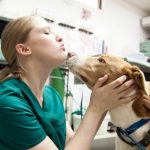Canine Hip Dysplasia occurs when a dog has an abnormal hip joint, it can affect one or both hips.
In This Article You Will Read About
Hip dysplasia in dogs is more common in the large and giant breeds, such as Rottweilers, Labrador Retrievers, Golden Retrievers, GSDs, Great Danes and more.
But any breed can be affected, including those with a mixed-breed family tree if that tree includes susceptible breeds.
Although it’s often a hereditary condition (genetic) it can also be caused by environmental factors during times of critical developmental and growth, which are basically puppyhood and adolescence.
Check out my Hip Dysplasia In Dogs page to learn all about the causes & prevention of this condition.
Symptoms Of Canine Hip Dysplasia
The symptoms of hip dysplasia often show up in puppies, somewhere between the ages of 6 months and 1 year.
They can occur earlier, or later, but tend to appear during the rapid growth periods that accompany puppyhood!
Here are some of the most common signs that your pup could have a problem with his hips…
- Weakness, discomfort or pain in the back legs.
- Shows a limp or lameness in one or both back legs.
- A bouncy, hopping, ‘rabbit-like’ walk or run.
- Difficulty getting up from the lying down position.
- A clicking sound that’s noticeable when the pup/dog is walking
- Back feet which seem to be very close together when standing/walking
It’s also important to know that not all dogs with abnormal hips will show the above signs, or they may be so slight as to go unnoticed.

There is a genetic component in canine hip dysplasia, and a dog can be a ‘carrier’ of the gene without actually showing any symptoms of the disease.
This is why proper evaluation of a dogs’ hips is essential before he/she is used as part of a breeding program.
Diagnosing hip dysplasia in dogs is usually done by taking X-rays of the hips while manipulating them.
The dog is sedated during the procedure, and the resulting X-rays are evaluated and rated by one of two different methods.
Either the OFA (Orthopedic Foundation For Animals) system, or the PennHIP system.
Treating Hip Dysplasia In Dogs
There are several possible treatment options for canine hip dysplasia.
Which one you choose depends on several things, including your dogs size, weight and general health.
You also need to take into account how severe the problem is, and how long your puppy or dog has been suffering from this condition.
Some approaches can eliminate the problem, others may only alleviate symptoms such as pain and inflammation.
Some are designed to minimize progression of the disease.
Surgical Options
Several surgical procedures are available to treat canine hip dysplasia, and these can often correct that actual physical defect (malformation in the hip joint) by re-shaping or replacing parts of the joint, or the hip itself.
There are 4 main types of dog hip surgery –
- Juvenile Pubic Symphysiodesis (JPS)
- Triple Pelvic Osteotomy (TPO)
- Femoral Head Ostectomy (FHO)
- Total Hip Replacement
These vary in the degree of invasiveness, difficulty and cost.
Also, some are best done on dogs under a certain age, or weight, etc. Your veterinarian or veterinary specialist will be the best person to decide which procedure is going to be best for your dog.
Surgery might seem like a scary option, but it may be necessary if the dysplasia is severe. It is expensive, and the recovery time is significant, but it can make all the difference in the world to a dog with bad hip/s.
If you want to get an idea of what’s involved and what the convalescence afterwards is like, check out this submission made by a regular visitor to my site… 11 month old male rottie, Barron, is having hip replacement surgery.
You can follow Barron the Rottweiler’s owner Bonnie, from her initial worries about his upcoming surgery, right through to the relief of his recovery.
Medicinal Options
There are some medications, supplements and environmental changes that can help treat the pain, inflammation and resulting inflammatory changes that are part of living with canine hip dysplasia.

Oral supplements such as Glucosamine Chondroitin Tablets can help to repair some of the damage that this condition causes to the cartilage; Omega-3 Fatty Acids have anti-inflammatory properties; Vitamin C has anti-oxidant properties; Methyl-sulfonyl-methane (MSM) has both an anti-inflammatory and pain-relieving effect.
There are drugs that can be used to treat hip dysplasia symptoms in dogs, these include Buffered Chewable Aspirin, corticosteroids, anti-inflammatory and/or injectable osteo-arthritic medications such as Rimadyl, Dermaxx or Previcox .
You should never give your pup or dog any medications (human or canine) that haven’t been presribed by your veterinarian though.
To learn more about using Aspirin safely check out this page – Aspirin For Dogs.
You can also get all the information you need about the most popular pain medicines used for treating the pain and inflammation of canine hip dysplasia, canine arthritis and other bone/joint problems on this webpage – Pain Medication For Dogs.
Environmental & Lifestyle Changes
Although they can’t cure canine hip dysplasia, certain dietary and lifestyle modifications can help to slow down, reduce or manage a dogs symptoms. Sometimes a few simple changes can make a big difference.
Things such as weight-management are key, even if your dog is also undergoing surgical or medical treatments. Extra weight puts extra strain on the entire skeleton including the hip joints, and obviously this will make any problem worse.
The right balance of exercise and rest is also important. Too much exercise, or too little, can cause problems though. The best sort of exercise is limited DAILY activities such as walking or swimming. Avoid high-impact exercise.
Getting your dog a comfortable dog bed made from orthopedic foam can make him a lot more comfortable, and protect his painful joints from the hard floor. Heat helps too, and a heating pad is great in the winter months.
Alternative treatments such as canine massage, herbal or homeopathic medications (see Agile Joints Herbal Support or HomeoPet Joint Stress Relief for example) or acupuncture etc. can also be beneficial and are worth looking into.
If your pup or dog does develop canine hip dysplasia, or any other serious disease or injury, the cost of veterinary care can be pretty high!
However, if you have health insurance for your dog it can literally be a life-saver.
With large and extra large dog breeds, such as Rotties, the costs of everything from food to medications also tend to be of the XL variety, so protecting your dog (and your savings) by having your dog covered makes a lot of sense.
Here’s one of the top Pet Health Insurance companies for you to check out.
You’ll be surprised at how much protection you get for a low monthly payment.
You can get a FREE, no-obligation quote just by clicking on the links below…..

Related Pages….

